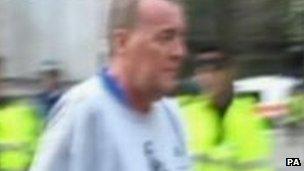G20 death trial hears Met PC's 'blood was up'
- Published

PC Harwood's reaction was "wholly disproportionate" in the circumstances, the court heard
Newspaper vendor Ian Tomlinson died at the G20 protest in London in 2009 as the result of a "gratuitous act of aggression by a lone officer whose blood was up", a court has heard.
PC Simon Harwood, 44, of Carshalton, south London, who denies manslaughter, is on trial at Southwark Crown Court.
Jurors heard Mr Tomlinson, 47, was violently struck with a police baton and pushed to the ground.
The prosecution says this caused him to collapse two to three minutes later.
'Taken by surprise'
Mr Tomlinson had been trying to walk home on 1 April 2009 but had found his usual route blocked due to the G20 protests that day.
Mark Dennis QC, for the prosecution, said there was a "clear temporal link" between the violence Mr Tomlinson was subjected to and his death.
He was facing away from PC Harwood and would have been "taken completely by surprise" when he was hit, and would have had little opportunity to protect himself from a heavy fall, jurors were told.
"Ian Tomlinson was not posing any threat to the defendant or any other police officer," Mr Dennis told the court. PC Harwood's reaction was "wholly disproportionate" in the circumstances, the court heard.
Mr Dennis continued: "The display of force has all the hallmarks of a gratuitous act of aggression by a lone officer whose blood was up, having lost the self control to be expected of a police officer in such circumstances, and who was going to stand no truck from anyone who appeared to be a protester and to be getting in his way."
Initially pathologist Dr Freddy Patel found that Mr Tomlinson had died from a heart attack, but questions were raised when an American tourist came forward with a film recording of him being hit.
Further medical reports suggested that in fact he died from an injury to his liver which caused internal bleeding and then cardiac arrest.

Ian Tomlinson, a heavy drinker, had seemed "oblivious" to his surroundings on the day he died
Mr Tomlinson had been homeless for several years during his life and was a heavy drinker, suffering from cirrhosis of the liver.
He had been drinking from early morning on the day he died, and by shortly after 19:00 GMT, when he first encountered the police, he seemed "somewhat oblivious" to his surroundings, the court heard.
An officer who spoke to him at a road block near Bank said that Mr Tomlinson was not angry about not being able to take his normal route home to Smithfield, but stared at him in "incomprehension".
Baton 'ready'
Meanwhile, PC Harwood, who was tasked with driving a police carrier and monitoring radios that day, had tried to arrest a protester who he had seen trying to write something on the side of a police van.
However, the demonstrator managed to wriggle free while others cheered, which Mr Dennis said, would have left the officer "embarrassed if not humiliated".
He then decided to join other officers who were on foot in Threadneedle Street.
Mr Dennis said PC Harwood was "assuming the posture of someone who was ready to take on the protesters", standing with his baton "ready for immediate use".
Jurors were shown a series of stills from video footage, including Mr Tomlinson clutching his right side after being hit.
He walked about 70m along Cornhill away from PC Harwood before he collapsed, the court heard, and complained that he had only been trying to get home.
Passers-by, including a medical student, tried to save Mr Tomlinson, but he died in hospital at about 20:10.
Later, PC Harwood made a statement in which he made no specific reference to the incident.
He said he had used "reasonable force in order to clear police lines", and went on: "I do not remember how many persons I struck, but done (sic) so in order to prevent any further rioting and to preserve my safety."
He maintains that his actions against Mr Tomlinson were "necessary, proportionate and reasonable" in the circumstances.
The trial, which is expected to last between four and five weeks, continues on Tuesday.